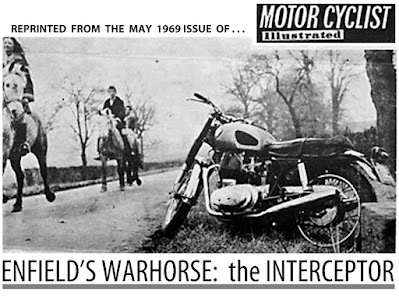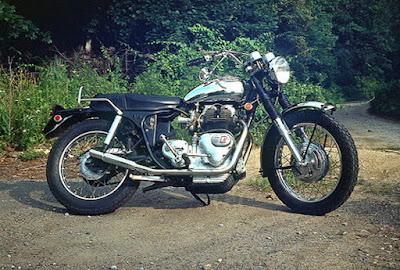 |
| The Royal Enfield Interceptor of 1969 inspired awe and admiration. |
"Enfield's Warhorse: the Interceptor" is the title of a May, 1969 article in the Motor Cyclist Illustrated magazine.
The reference to equine power is not just in the headline. The article begins:
"It is an obvious, though romantic allegory, the Interceptor, and a Shire. Not the ponderous dray-horse of today, but their ancestors, bred in the Middle Ages as thundering great war horses; powerful enough to carry at full gallop a heavily armored knight; fast enough to run down the fleeing, poorly mounted foreign invaders, and magnificent enough in themselves to become as legendary as the men who rode them."
The writer was Dave Minton, a motorcycle journalist and author. His words are a classic tribute to the mighty Royal Enfield Interceptors of yore.
Stirring words, indeed, but the comparison is perhaps more suited to the lithe and lean new Royal Enfield Interceptor and Continental GT 650s of today than the 750 Interceptors of 1969.
That's right, I haven't got it backward. It turns out that Medieval war horses may have been bred for cut-and-thrust warfare, not bowling enemy soldiers over with their size.
"A team of archaeologists and historians searching for the truth about the steeds that carried knights into battle has concluded that most were probably only the size of a modern-day pony," The Guardian reported in January.*
But never mind. You know what Minton means. And he carries on:
"One of the best examples of large capacity British motorcycles has been virtually overlooked, at least in this country, despite its popularity in the USA -- the Royal Enfield Series II Interceptor, a 750cc Shire Stallion of the motorcycle world.
"A big, brawny, muscular machine. A deep-chested, galloping pacemaker, strong enough to give whatever is demanded of it without effort, it matters little as to the gear used, or where the throttle is, or what the revs are, or the weight carried, or how strong the wind is, or the steepness of the hill, the Interceptor will pound away until it has fulfilled the wishes of its rider. Without fuss or bother you simply fly away from the rest of the world followed by nothing except the deep baying of the exhaust.
"If you are the type who spends his days dreaming of hair trigger two-strokes with more working parts to the gearbox than engine, then forget it, put the story down now while your mood is still equable, because you will just hate this one. It's a bike to bring out the worst in a man...
"I just loved it." That might have summed and capped up his whole article.
But... no.
There's much, much more. The author writes that the 1969 Interceptor forever put to rest complaints that Royal Enfield motorcycles are slow and unreliable. It started from stone cold on the second kick without fail, didn't vibrate, and the clutch didn't act up in the heaviest traffic.
He even claims it didn't leak oil.
It's a four page article and we're still only on page one.
We finally get criticisms on page two and they're no fault of the motorcycle, but attributed to a decision to market it to Americans.
The Interceptor was comfortable for half an hour, but then its soft seat collapsed onto the pan and the forward positioned foot pegs took a toll on the thighs. Thankfully "American style" handlebars were not fitted, sparing the author "severe strain to the back, arms, and fingers bracing against the wind."
Minton turns a bit picky when he complains of the tool sizes required by the Interceptor. "Either two or three (I forget which) Philip head screw sizes. A similar number of ordinary slotted and Allen screws. Now that is not fair, for as well as the usual quantity of spanners even more tools are required."
If the Interceptor is as good as he says, why does he need tools?
Minton did not find the Interceptor's handling faultless, but he excuses his mention of this by explaining that Royal Enfield had encouraged him to be honest, making "my last few remarks a little more searching than is usual practice."
I thoroughly enjoyed reading his thoughts. Pointed, exaggerated and idiosyncratic, they place the Interceptor, British motorcycling, and motorcycle magazines in general in their period context.
No the Interceptor wasn't faultless; no one would have believed that. But reading about it sure was fun.
The now 53-year-old magazine article was posted on the Interceptor Forum by Ward, a member in New York state.
 |
| Ward's Royal Enfield Series II Interceptor, a heartbreaker. |
Ward also posted a photo with it.
"Attached is my Series 2, in 1977. I sold it in a fit of pique in 1992, alas," he wrote.
In an email to me later he explained:
"I worked ceaselessly to correct my bike's faults, for 17 years, naively believing that if I got everything in top condition, bone stock, meticulously fitted and assembled, my efforts would be rewarded with a trustworthy machine, but it defeated my best efforts. And I am an aircraft mechanic by trade.
"I did manage to get $2,000 for it, as a gleaming showpiece that had the heart of a whore. Clutch, gearbox, oil leaks, we all know the list of genetic defects. My heart still aches at the thought of what might have been."
My thanks to him and author Dave Minton for an amusing wintertime read.
*Here's more about the actual warhorse of legend:
"It turns out that things are not quite as they have usually been portrayed,'' according to Alan Outram, study co-author and archeologist at the University of Exeter... "In popular culture, warhorses are often depicted as the size of a shire horse. It really wasn’t like that. Most medieval horses are surprisingly small. Selection and breeding practices in the Royal studs may have focused as much on temperament and the correct physical characteristics for warfare as they did on raw size.''


























The Series II was nothing more than an attempt to cheapen up the manufacturing process without improving performance or much of anything else. And in fact, in one way it made things worse. Series II owners are well aware that these bikes do not like warm-er weather. Since it's a wet sump design (to do away with the separate oil tank)the oil has little chance to cool down. This resulted in a golden opportunity to market an expensive oil cooler that helped..a little.
ReplyDeleteFor me personally, I think the motor looks more agricultural than it's predecessors, which translates into too tall and ungainly. I much prefer the more organic lines of the Mk1 and 1A's motors.
But to each his own.
Any Enfield is a worthy addition to any collection despite is mechanical shortcomings.